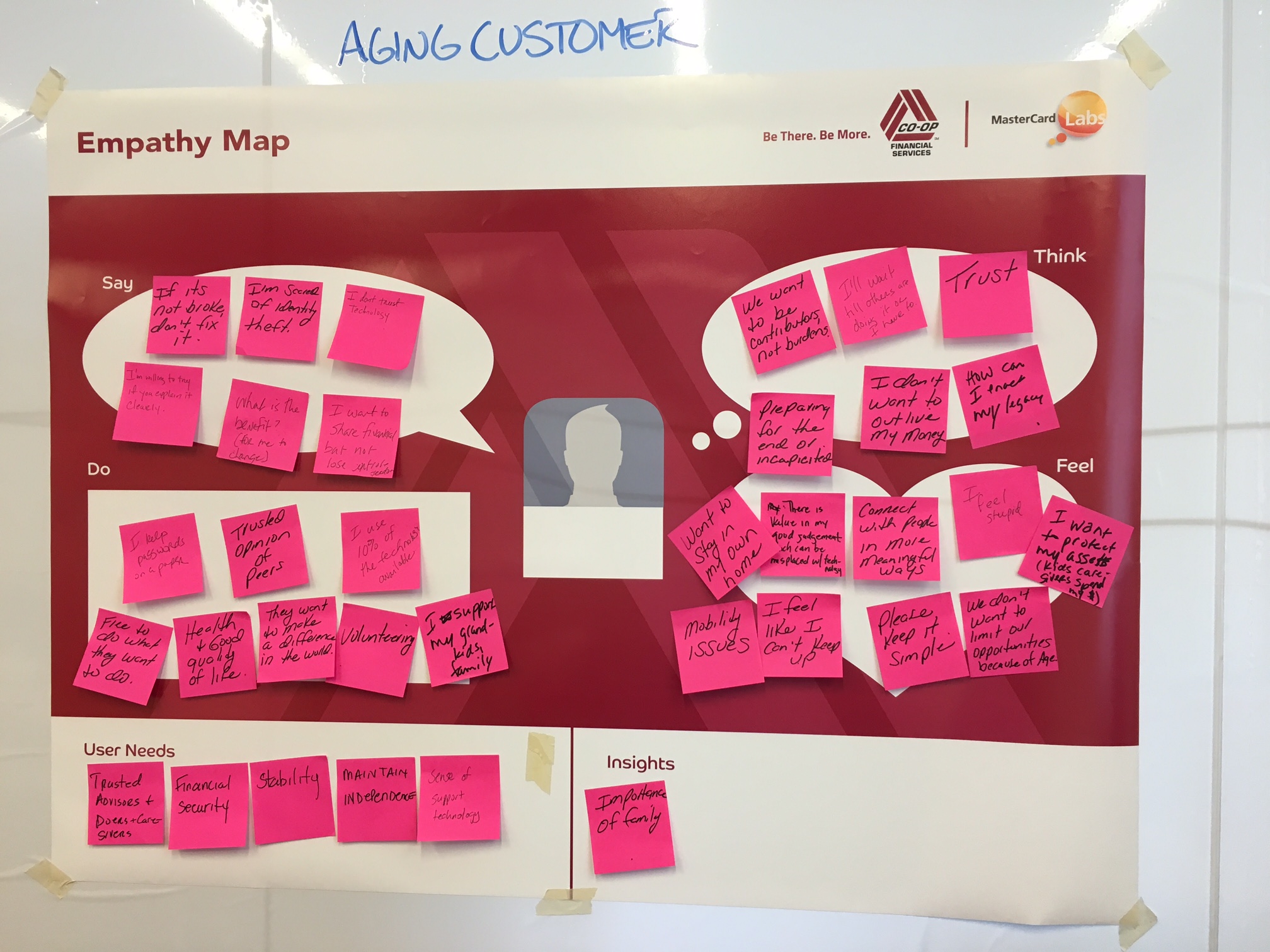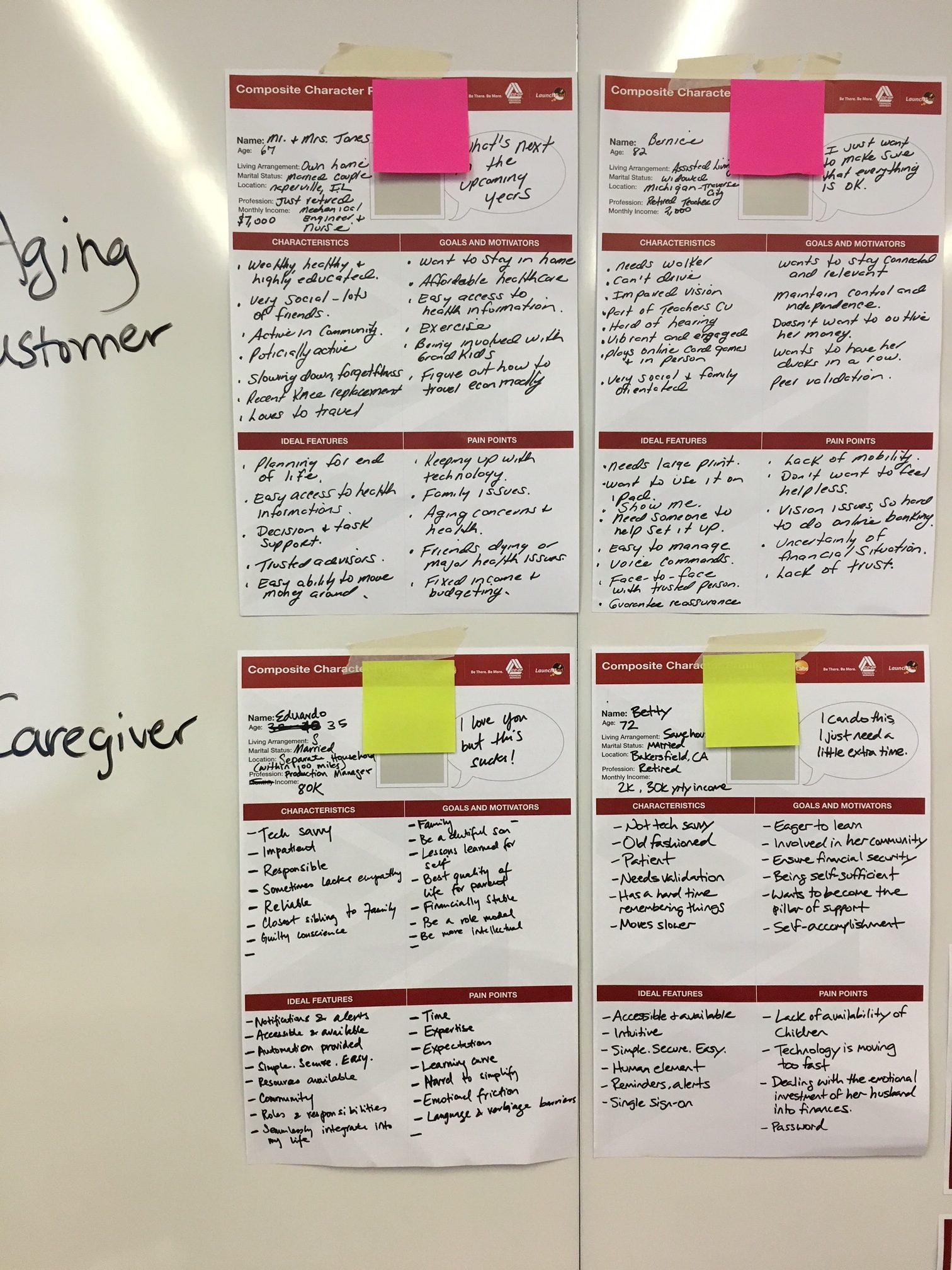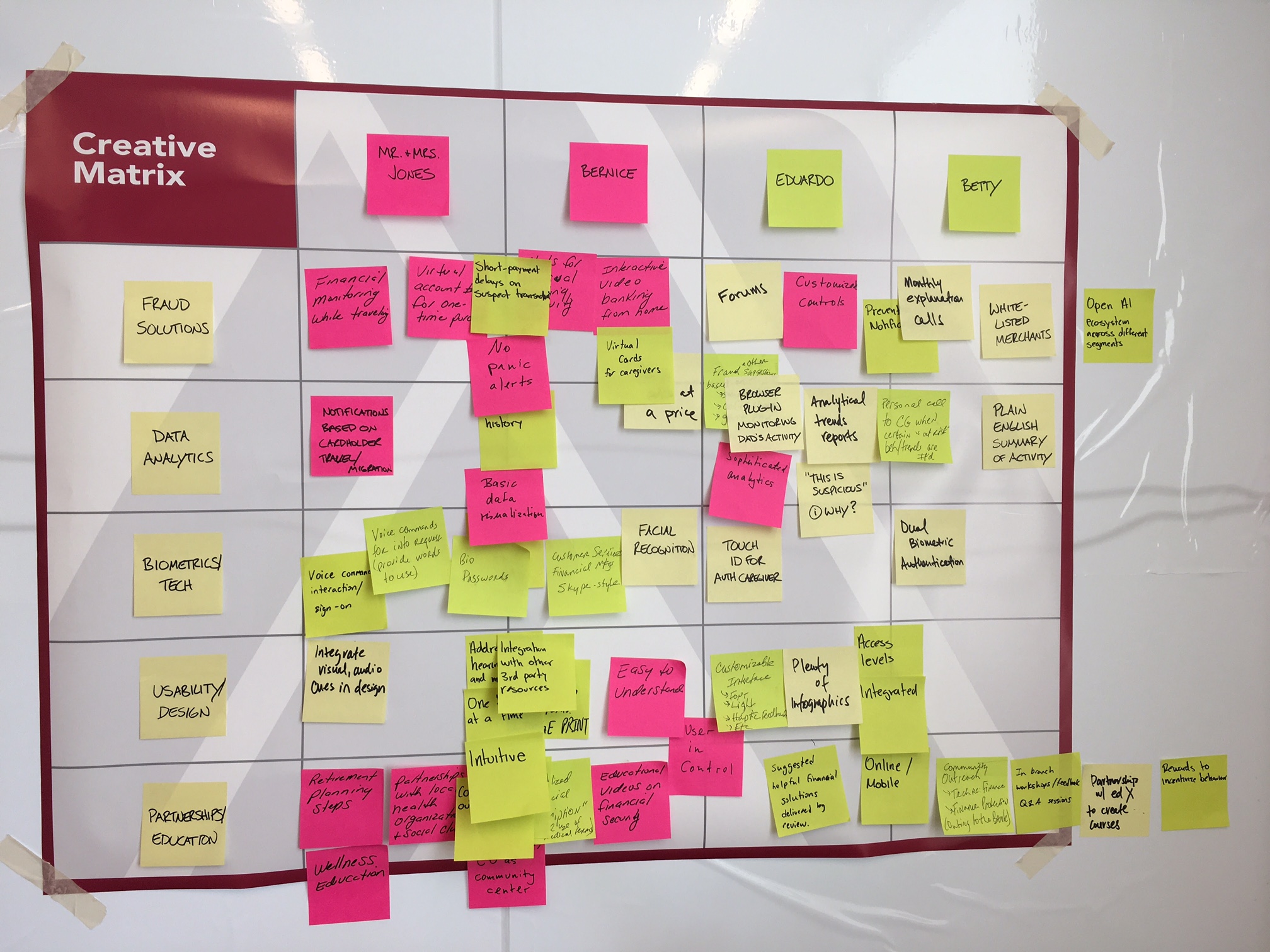Ideating Beyond Stereotypes: What Aging Consumers Really Need
Creating a product that breaks through stereotypes about aging requires two things. First you must abandon everything you think you know about people in midlife and beyond. And second, you must learn what this market actually wants and needs. Only then can creativity find a purposeful direction.
As part of the MasterCard Labs LaunchPad project, a team of developers, designers, experts on aging and business stakeholders began the ideation process with some key insights about aging Americans. They began by considering some of the challenges older consumers face when trying to use technology:
When people reach the age of 40, the majority experience decreased color vision, especially when it comes to blue. The ability to see in low lighting decreases and the visual field declines. Additionally, the older population deals with the same aggravations noted by the overall smartphone/tablet user base. Per research, nearly half experience content as not displaying properly, poor or dropped signal quality, and apps not working correctly. In addition, aging people also face changes in their sensory, motor and cognitive skills. Because of this, they can take more time to learn, experience more errors, and forget how to operate a system.
However:
 An empathy map (above) was created as a collaborative tool the team could use to gain a deeper insight into the member segment. It helped the team to immerse itself in the user’s environment in order to elaborate on user personas and and capture behaviors and mindsets.
An empathy map (above) was created as a collaborative tool the team could use to gain a deeper insight into the member segment. It helped the team to immerse itself in the user’s environment in order to elaborate on user personas and and capture behaviors and mindsets.
 Composite character profiles like the one shown above helped the team to bring their end users to life, give them a story, make them real.
Composite character profiles like the one shown above helped the team to bring their end users to life, give them a story, make them real.
 From there, a customer journey map (above) helped the team visualize the process that target users go through in order to accomplish specific goals. The map helped the team understand and address customer needs and pain points.
From there, a customer journey map (above) helped the team visualize the process that target users go through in order to accomplish specific goals. The map helped the team understand and address customer needs and pain points.
 Last but not least, the team brainstormed around specific ideas that came up throughout the first day. Voice control came up as a possible preference for interacting with the digital product. Video chat was also suggested, since older people prefer personal contact to impersonal interaction with technology. As the team contemplated different ideas, they kept in mind possible opportunities to integrate and/or partner with existing solutions and tailor them towards this age group.
Last but not least, the team brainstormed around specific ideas that came up throughout the first day. Voice control came up as a possible preference for interacting with the digital product. Video chat was also suggested, since older people prefer personal contact to impersonal interaction with technology. As the team contemplated different ideas, they kept in mind possible opportunities to integrate and/or partner with existing solutions and tailor them towards this age group.
 The LaunchPad team synthesized their ideas to focus the problem and offered solutions further. The creative matrix (above) helped to narrow down the broad problem and break away from conventional thinking. It also helped to generate even more ideas.
Jane Hamill, the founder of Fashion Brain Academy, wisely said: “Multiple creative ideas can be the kiss of death for an entrepreneur. It’s time to choose.” How did the LaunchPad team cull through their ideas to create a single product? Stay tuned for the third part of this series to find out.
In the meantime, contribute your own ideas on serving the financial needs of an aging population by joining the 2016 THINK Prize Challenge. Through our renewed partnership with OpenIDEO’s global community, we welcome your participation. Share your experiences and collaborate to create solutions that are smart, simple, secure, and tailored to older adults. CO-OP will award the 2016 THINK Prize to one or more top ideas resulting from this process.
Please join now and compete for the $10,000 THINK Prize.
The LaunchPad team synthesized their ideas to focus the problem and offered solutions further. The creative matrix (above) helped to narrow down the broad problem and break away from conventional thinking. It also helped to generate even more ideas.
Jane Hamill, the founder of Fashion Brain Academy, wisely said: “Multiple creative ideas can be the kiss of death for an entrepreneur. It’s time to choose.” How did the LaunchPad team cull through their ideas to create a single product? Stay tuned for the third part of this series to find out.
In the meantime, contribute your own ideas on serving the financial needs of an aging population by joining the 2016 THINK Prize Challenge. Through our renewed partnership with OpenIDEO’s global community, we welcome your participation. Share your experiences and collaborate to create solutions that are smart, simple, secure, and tailored to older adults. CO-OP will award the 2016 THINK Prize to one or more top ideas resulting from this process.
Please join now and compete for the $10,000 THINK Prize.
- Older does not mean less effective.
- Older adults often compensate well for a decrease in health. If they decline in perceptual-motor measure, they usually look farther ahead.
- Older people learn skills more readily when they call upon previous expertise.
- Perceived usefulness: the degree to which a person believes that using a particular system would enhance his or her job performance, and
- Perceived ease of use: whether people can use the system without much effort.
 An empathy map (above) was created as a collaborative tool the team could use to gain a deeper insight into the member segment. It helped the team to immerse itself in the user’s environment in order to elaborate on user personas and and capture behaviors and mindsets.
An empathy map (above) was created as a collaborative tool the team could use to gain a deeper insight into the member segment. It helped the team to immerse itself in the user’s environment in order to elaborate on user personas and and capture behaviors and mindsets.
 Composite character profiles like the one shown above helped the team to bring their end users to life, give them a story, make them real.
Composite character profiles like the one shown above helped the team to bring their end users to life, give them a story, make them real.
 From there, a customer journey map (above) helped the team visualize the process that target users go through in order to accomplish specific goals. The map helped the team understand and address customer needs and pain points.
From there, a customer journey map (above) helped the team visualize the process that target users go through in order to accomplish specific goals. The map helped the team understand and address customer needs and pain points.
 Last but not least, the team brainstormed around specific ideas that came up throughout the first day. Voice control came up as a possible preference for interacting with the digital product. Video chat was also suggested, since older people prefer personal contact to impersonal interaction with technology. As the team contemplated different ideas, they kept in mind possible opportunities to integrate and/or partner with existing solutions and tailor them towards this age group.
Last but not least, the team brainstormed around specific ideas that came up throughout the first day. Voice control came up as a possible preference for interacting with the digital product. Video chat was also suggested, since older people prefer personal contact to impersonal interaction with technology. As the team contemplated different ideas, they kept in mind possible opportunities to integrate and/or partner with existing solutions and tailor them towards this age group.
 The LaunchPad team synthesized their ideas to focus the problem and offered solutions further. The creative matrix (above) helped to narrow down the broad problem and break away from conventional thinking. It also helped to generate even more ideas.
Jane Hamill, the founder of Fashion Brain Academy, wisely said: “Multiple creative ideas can be the kiss of death for an entrepreneur. It’s time to choose.” How did the LaunchPad team cull through their ideas to create a single product? Stay tuned for the third part of this series to find out.
In the meantime, contribute your own ideas on serving the financial needs of an aging population by joining the 2016 THINK Prize Challenge. Through our renewed partnership with OpenIDEO’s global community, we welcome your participation. Share your experiences and collaborate to create solutions that are smart, simple, secure, and tailored to older adults. CO-OP will award the 2016 THINK Prize to one or more top ideas resulting from this process.
Please join now and compete for the $10,000 THINK Prize.
The LaunchPad team synthesized their ideas to focus the problem and offered solutions further. The creative matrix (above) helped to narrow down the broad problem and break away from conventional thinking. It also helped to generate even more ideas.
Jane Hamill, the founder of Fashion Brain Academy, wisely said: “Multiple creative ideas can be the kiss of death for an entrepreneur. It’s time to choose.” How did the LaunchPad team cull through their ideas to create a single product? Stay tuned for the third part of this series to find out.
In the meantime, contribute your own ideas on serving the financial needs of an aging population by joining the 2016 THINK Prize Challenge. Through our renewed partnership with OpenIDEO’s global community, we welcome your participation. Share your experiences and collaborate to create solutions that are smart, simple, secure, and tailored to older adults. CO-OP will award the 2016 THINK Prize to one or more top ideas resulting from this process.
Please join now and compete for the $10,000 THINK Prize.
